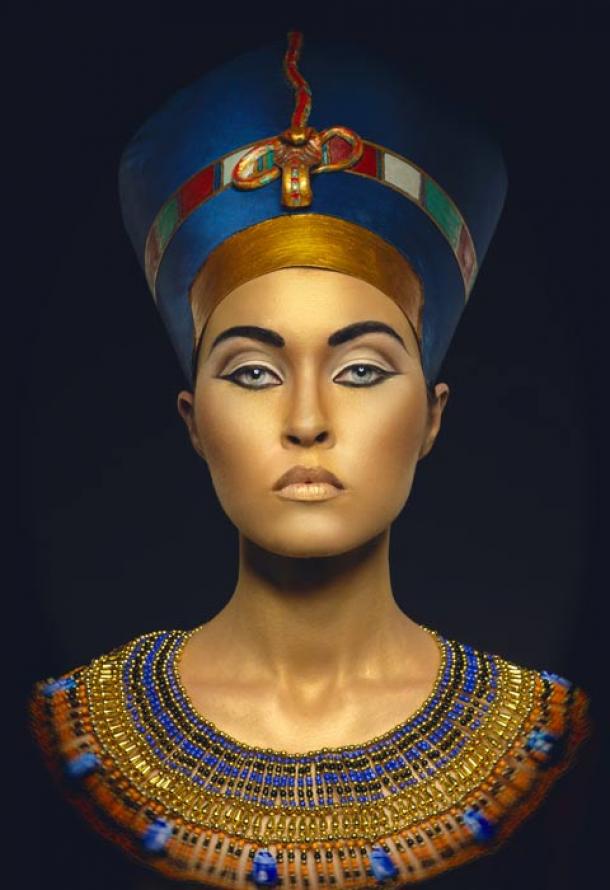
Ancient Egyptian Makeup: Beauty and Protection with Poison
It’s sort of like the evil eye, but in reverse: the good eye, brought on by an application of lead-based kohl makeup that was unknowingly poisonous to ancient Egyptians but also had anti-microbial properties. Plus there was the magical aspect of invoking the gods Horus and Ra with an application of the black makeup and further protective properties.
Makeup was for Everyone
In ancient Egypt, as modern archaeologists and Egyptologists can tell you, people from all classes, from laborers to royalty, applied kohl to their eyes. But this phenomenon of thick, black makeup has been known worldwide, and people still apply it in North Africa and Central Asia, says an article about the practice on Discovery.com.

Statues of an Egyptian priest and his wife. Both appear to be wearing kohl. (vlad_g /Adobe Stock)
What was in Egyptian Makeup?
The components of kohl in Egypt were many and some quite rare and expensive, Discovery says. The main ingredient was galena or lead sulfide, a metallic mineral. Presumably for the rich it also had ground, precious gems, including rubies, emeralds, and pearls. It also contained silver and gold, coral, and the substance known today primarily as an incense, frankincense (see this story on Ancient Origins for an exploration of the euphoric and ritual properties of frankincense). It also contained medicinal herbs of neem, saffron, and fennel.
- Treatise on Make-up and Jam: A Bestselling Cookbook by Nostradamus
- A Brief History of the Enduring Iconic Female Phenomenon of Red Lipstick
- Ancient Egyptian Mummy Head Shows Woman Had Skin Condition Due to Beauty Practice
The ancients then diluted all these substances with liquids that made them more applicable to the eye, including water, milk, animal fats, and oil.
Kohl was Popular Ancient Makeup
According to Discovery, kohl was present in more places around the world than just ancient Egypt:
Kohl’s vast presence throughout history and across the globe testifies to its cultural, social, and hygienic purchase and evidence for its usage has been unearthed at the sites of ancient civilizations across North Africa, Central Asia, the Mediterranean and East Asia. It’s an incredibly old product, having been present since the Bronze Age (3500-1100 BC) and it’s usage has even been alluded to in the Old Testament, with two allusions at Kings II 9:30 and Ezekiel 23:40 to “painted eyes”.

Moroccan green bottle with black kohl. (Picture Partners /Adobe Stock)
Different people called it by different names. Arabs and people in modern Egypt still call it kohl, while ancient Romans and Greeks called it kollurion and modern Indo-Pakistanis name it surma.
But this Beauty Product was Poisonous
Knowridge Science Report says that some samples of the complex chemical from 52 ancient kohl containers underwent examination by French scholars in 2010. They found four types of lead, including galena and laurionite. Neither the laurionite nor another lead chloride, phosgenite, occur naturally in Egypt. This means they were brought in for the manufacture of lead oxide and kohl, Discovery says. The French researchers’ paper says this may have been the “the first known example of a large scale chemical process.”
These types of lead compounds (and other types of heavy metals) often are found in today’s eyeliners in North Africa and Central Asia, which may lead to lead poisoning. “This is particularly a serious issue with young children sporting the cosmetic as protection against the evil eye, as they are more likely to engage in hand-to-mouth behavior while learning about their environment,” says Discovery.

A man and his granddaughter in India with kohl around her eyes. Scholars are concerned about the presence of lead in today’s eyeliner in some regions of the world. This thick, black makeup also had lead in it in ancient times, but the ancients still may have benefited somewhat from antimicrobial properties of the beautifier. (Jorge Royan/CC BY SA 3.0)
There was a Positive Side
In ancient times lead was not known as a poison. But even with it present in kohl, the makeup gave the antibacterial protection and also may have reduced cataracts, blindness, and ocular scarring by way of activating an immune response and killing bad bacteria to prevent infections.
- Ten Unusual Ancient Traditions that Would Not Thrive Today
- Swans Fat, Crocodile Dung, and Ashes of Snails: Achieving Beauty in Ancient Rome
- Bygone Beauty and Body: The Origins of Cosmetics in the Ancient World
The knowledge of ancient Egyptians and their salves, ointments and makeup were considered so advanced that we got our word for chemistry from them. Says a story on the American Chemical Society website about the French researchers’ work:
“It is no wonder that kemej, the Egyptian word that referred to the Egyptian land and to the black earth of the Nile valley, was handed to us via the Greeks and then the Arabs to eventually coin our present chemistry.”

A modern representation of ancient Egyptian makeup. (FlexDreams /Adobe Stock)
Top Image: Egyptian eye makeup helped prevent infections, but it was poisonous. Source: FlexDreams /Adobe Stock
By Mark Miller
















Comments
Thank you for an interesting article. I had a vague idea about ancient Egyotian eyemakeup but I never knew any details. Also, thank you for the links. I truely enjoyed reading them. Great article